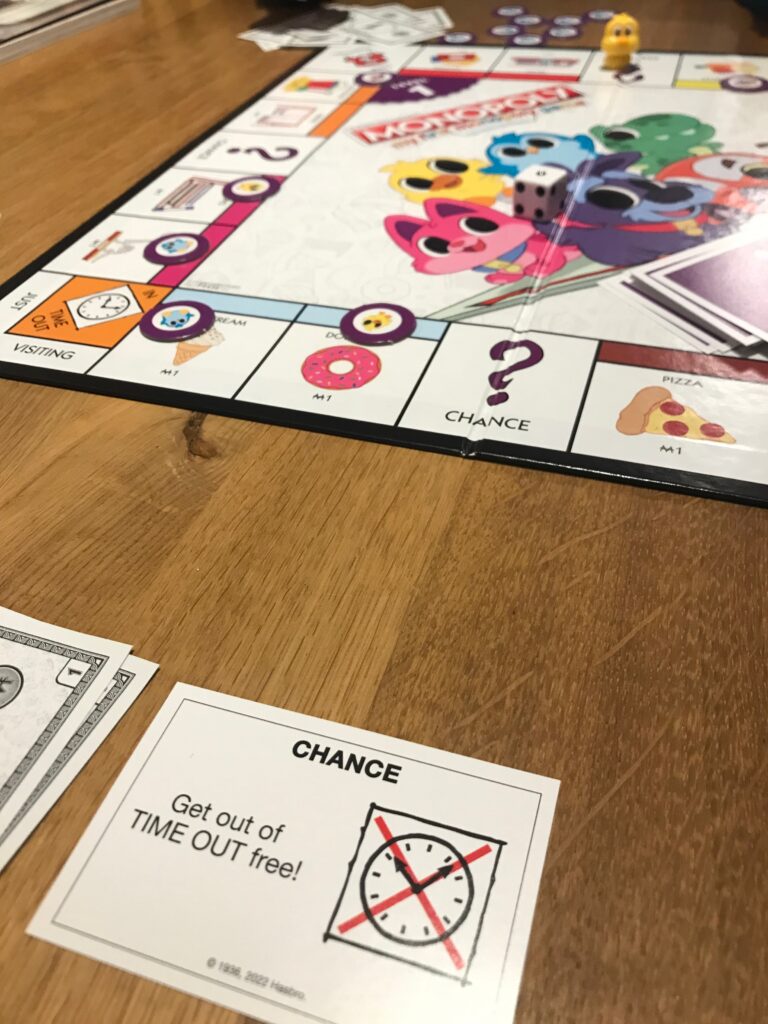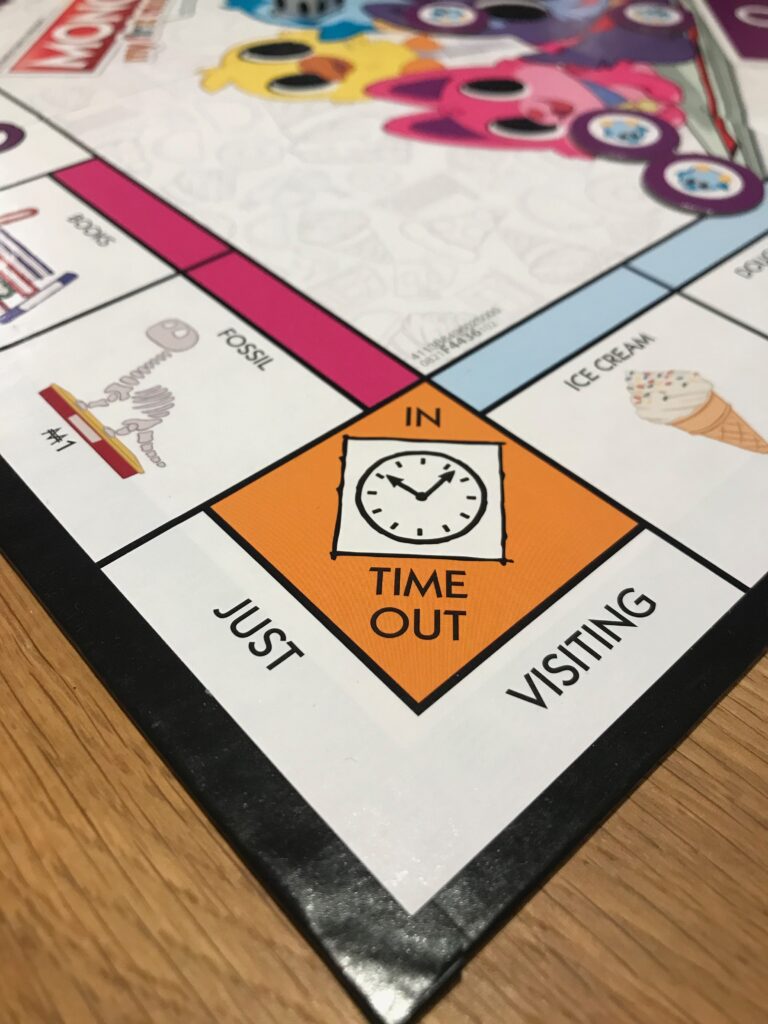Monopoly is one of those games that divides families. It’s a bit like marmite. Some people love it; others loath it. My son falls into the love camp at the moment. So much so that I’ve agreed to play a game a month with him for every month of 2023. I’ll be honest – three months in, it’s a bit of a faff, but he loves it and that’s the most important thing. As a child I absolutely loved the game though, so I can see where he’s coming from. When younger he dabbled with Monopoly Junior, but soon moved on to the main game. I’d assumed our youngest would do the same until we came across My First Monopoly whilst she was on a playdate at a friend’s house. This has been a bit of a game changer.

Now, my four year old is pretty good at games. She has plenty of Orchard Toys and Haba ones of her own, but we also play a lot of Snakes and Ladders and Ludo with her too. Quite often she also “helps” when we play something like Azul or Railroad Ink, and we play a version of Carcassonne with her that just involves laying tiles and she loves “the map game” as a result. What I realised we had never done though is play a game with her that involves money. At just 4 it’s not something she’s encountered in games or structured play at school yet. Yes she has play money and plays shops or cafes regularly with her cuddly toys, but her pricing can be a little wild at times!
Breaking down Monopoly
If you think about it Monopoly has quite a lot of different mechanisms in it. You have to roll the dice to go around the board. Upon landing on a property players can then choose to buy it and if they do so they then get to charge rent to other players who land on it in the future – looking up on the title deeds how much they have to pay. Houses and hotels can be built on property, increasing the rent as they do so. There’s also the act of picking up Chance or Community Chest cards too. Simple to anyone familiar with board games, but not so much your average four year old.
This is where My First Monopoly comes into its own. It’s basically broken down the things you need to know to play a full game of Monopoly and looked at how you can introduce them to young kids. In doing so they’ve also thought about when children learn to read, as it is somewhat pointless setting up a game which involves having to read instructions on the board or on cards until they can actually read. In My First Monopoly you get a double sided board and with it there are two versions of the game. One for 4-5 year olds (Level 1) and a second (Level 2) for ages 6+. We’ve been playing the easier version (the purple one) with our 4 years old, but I will cover both here.
My First Monopoly – what’s in the box?
Some of the components of My First Monopoly will look very familiar to those of you that have played the main game of Monopoly before.

There’s a two sided game-board, 6 colourful playing pieces and 6 corresponding character cards. 16 Title Deed Cards matching the properties on the Level 2 side of the game board and there are 20 Chance cards for each of the two levels (so 40 in total). 1 Die, Money containing One and Five notes and 72 “sold signs”. These sold signs are actually double sided round tokens featuring one of the 6 playing piece characters. 12 for each character. On one side there is a purple boarder (for the level 1 game) and on the other it is turquoise for the level 2 game.
Level 1 – for little kids
This first game of My First Monopoly focuses on counting and matching. It’s impossible to go bankrupt in the game and the game ends when all the properties around the board have been purchased. Properties are named by what is in the picture so for instance there is a pile of books and a bucket and spade for properties that someone older would translate as being the library and the beach.
Children start on the familiar Go square and roll the dice to work their way around the board. There are 16 properties in total, four on each side and two of each colour. If you land on a property you have to buy it. When you do so you pay the bank £1 (or technically 1 unit of Monopoly currency, but I’m going to call them pounds!) and put one of your tokens on the square to show it is yours. To make it simple all properties on the board cost £1.

If a player lands on a square that someone else owns they pay £1 to that player as rent. If a player owns both properties in a colour set then the rents doubled to £2. Landing on a Chance Square means having to take a Chance card and these can send you to a specific square on the board (done via pictures rather than words) or tell you to go forwards number of spaces. There are also “Get out of Jail free” cards, but these have a twist that I will explain in a moment.
Landing on or passing Go means collecting £2 from the bank. Free Parking just means you rest there for a space.
The game ends once all the properties have been purchased and at that point the player that owns the most properties wins. Regardless of how much cash everyone has.
Time Out

One place where the game deviates slightly from the regular squares that we all know and love is when it comes to jail. It’s been decided that sending a 4 year old to jail isn’t necessarily the right thing to do and so instead children are sent to Time Out. You can escape Time Out by paying £1 on your next turn or using a “Get out of Time Out” Chance card that you might have collected earlier in the game.
The rules for this Level 1 version of My First Monopoly also cover what to do if you run out of money. There’s the alternative of singing a song instead of paying to escape Time Out, or giving someone a complement in lieu of rent. If only real life was that nice!
Level 2 – for big kids
Level 2 of My First Monopoly is designed for children aged 6 and over and focuses on reading and simple maths. Title Deed cards are used and you have to be a bit more careful with your money as it is possible to go bankrupt. The game ends when one player goes bankrupt and then the remaining player with the most money wins.
When you land on a property in Level 2 you again have to buy it, but this time all properties have different values – much like in the grown up game. Properties also have proper titles now like the Museum and the Library. Once you’ve placed your token on the square you also get to take the Title Deed card for that property.
Rent is paid like in the Level 1 game and again the rent is doubled if both properties in a colour set are owned by the same person.

Chance cards in Level 2 are more involved and have things like telling you to go to a specific property, or coloured property and then if no one owns it you get it for free. There are also cards in there that tell you to collect money from the bank or from other players in the game.
Level 2 is definitely a step up from Level 1, but when you think about the difference in ability between your average 4 year old and average 6 year old in terms of understanding and reading and maths it seems right. And much more of a challenge for them too.
What we like about My First Monopoly
I’ll be honest and say that I’m not normally a fan of children’s versions of some games as often I think that the children could actually play the main game with just a few adaptions. I feel very differently though about My First Monopoly. I don’t think an average 4 year old could really properly be involved in a game of Monopoly as there’s just too much reading for them. My First Monopoly though gives them something that they can play independently, yet at the same time teaching them so much about the main game and the mechanics you need to play it. Just the familiar logo and the imagery used on the corner squares and Chance cards makes it feel very on brand. It is so very much a gateway towards the full game of Monopoly.
I like the way that so much thought has gone into the abilities at different ages, and making it a double sided game so that it appeals to a larger age range is always a winner from a parenting perspective. The playing pieces are lovely and colourful and very tactile – if a little tricky to stand up properly if you have large fingers! The art work on the board is the perfect mix between the familiar Monopoly elements and also being new and exciting for younger children.
Overall it’s a huge thumbs up from us. It’s rare that I go out and buy a new game or any sort for the kids as charity shops normally provide more than enough entertainment for them, but even after just one play on a playdate I felt very different about My First Monopoly and ordered a copy later that same day.
Where to buy My First Monopoly
My First Monopoly can be picked up in most toy and game shops, or is available from Amazon here and at the time of writing is reduced to £12.99 from an RRP of £22.99.
Disclaimer…
I bought my own copy of My First Monopoly. Some of the links in this post are affiliate links and if you go to Amazon via them and purchase anything I receive a small commission. It will cost you no more than if you had arrived at Amazon on your own. Many thanks for any purchases that you do make. Your support is very much appreciated.
